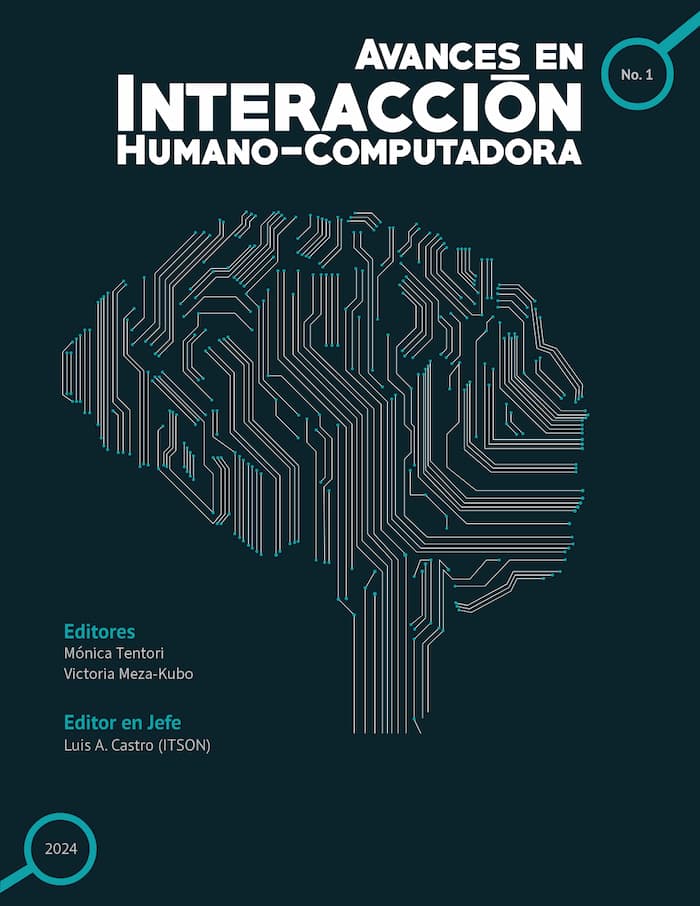Design of a Virtual Assistant for Emotional Support of Children with Autism Spectrum Disorder
DOI:
https://doi.org/10.47756/aihc.y9i1.154Keywords:
Emotional Wellbeing Technology, Assistive Technology for Autism, Child Emotional Health, Digital Therapy Tools, Assistance PetAbstract
Children with Autism Spectrum Disorder (ASD) face significant challenges in acquiring socio-emotional skills. This research focuses on exploring and understanding the characteristics of this topic to propose an application that includes a virtual assistant aimed at improving socio-emotional skills, centered explicitly on emotional recognition. This paper presents a thorough investigation to explore the use of innovative technologies on the subject and understand how to design the development of low-fidelity prototypes. This project aims to contribute to the emotional well-being of children with ASD through advanced technology.
Downloads
References
American Psychiatric Association. 2014. DSM-5: Manual diagnóstico y estadístico de los trastornos mentales.
Charmaz, K. 2014. Constructing grounded theory. DOI: https://doi.org/10.1002/9781405165518.wbeosg070.pub2
Autism prevalence higher, according to data from 11 ADDM communities. (2023, March 23). CDC. Retrieved May 9, 2024, from https://www.cdc.gov/media/releases/2023/p0323-autism.html
Bexson, C. Oldhan, G. & Wrays J. (2024). Safety of virtual reality use in children: review. European Journal of pediatrics, 183(5), 2071-2090. DOI: https://doi.org/10.1007/s00431-024-05488-5
Moon, j., & Ke. F 2021. Exploring the treatment integrity of virtual reality-based social skills training for children with high-function autism. Interactive Learning Environments,29(6), 939-953. DOI: https://doi.org/10.1080/10494820.2019.1613665
Appleby, R. 2022. Australian parents’ experiences of owning an autism assistance dog. Health and Social Care. DOI: https://doi.org/10.1111/hsc.13805
Johnson, C. P., & Myers, S. M. 2007. Identification and Evaluation of Children With Autism Spectrum Disorders. Pediatrics. DOI: https://doi.org/10.1542/peds.2007-2361
Burgoyne, L., Downling, L., Fitzgeral, M., Browne, J., & Perry, I. 2014. Parents' perspectives on the value of assistance dogs for children with autism spectrum disorder: a cross-sectional study. British Medical Journal Open. DOI: https://doi.org/10.1136/bmjopen-2014-004786
Solomon, O. 2010. What a Dog Cad do: Children with Autism and therapy dogs in social Interaction. DOI: https://doi.org/10.1111/j.1548-1352.2010.01085.x
Norman, D. A & Draper, S.W. 1986 User Center System Design: New Perspectives on Human-Computer Interaction.Lawrence Earlbaum Associates, Hillsdale, NJ.
Cheng, Yufang, Shu-Yun Luo, and Hsin-Chieh Lin. 2016. "Investigating the performance on comprehending 3D social emotion through a mobile learning system for individuals with autistic spectrum disorder." In 2016 5th IIAI International Congress on Advanced Applied Informatics (IIAI-AAI), pp. 414-417. IEEE. DOI: https://doi.org/10.1109/IIAI-AAI.2016.138
Baron-Cohen, S., Leslie, A. M., & Frith, U. 1985. Does the autistic child have a "theory of mind"?. Cognition, 21(1), 37–46. https://doi.org/10.1016/0010-0277(85)90022-8 DOI: https://doi.org/10.1016/0010-0277(85)90022-8
Garcia-Garcia, Jose Maria, María del Mar Caballero, Victor MR Penichet, and María D Lozano. 2019. "EmoTEA: teaching children with autism spectrum disorder to identify and express emotions." In Proceedings of the XX International Conference on Human-Computer Interaction, pp. 1-8. DOI: https://doi.org/10.1145/3335595.3335639
Altschuler, E. L. 2008. Play with online virtual pets as a method to improve mirror neuron and real-world functioning in autistic children. Medical hypotheses, 70(4), 748-749. DOI: https://doi.org/10.1016/j.mehy.2007.07.030
Norman, D. A., & Draper, S. W. 1986. User-centered system design; new perspectives on human-computer interaction. L. Erlbaum Associates Inc. DOI: https://doi.org/10.1201/b15703
Parsons, S., & Mitchell, P. 2002. The potential of virtual reality in social skills training for people with autistic spectrum disorders. Journal of intellectual disability research, 46(5), 430-443. DOI: https://doi.org/10.1046/j.1365-2788.2002.00425.x
Matson, J. L., Wilkins, J., & González, M. 2008. Early identification and diagnosis in autism spectrum disorders in young children and infants: How early is too early?. Research in Autism Spectrum Disorders, 2(1), 75-84. DOI: https://doi.org/10.1016/j.rasd.2007.03.002
p, H. H., Wong, S. W., Chan, D. F., Byrne, J., Li, C., Yuan, V. S., ... & Wong, J. Y. 2018. Enhance emotional and social adaptation skills for children with autism spectrum disorder: A virtual reality enabled approach. Computers & Education, 117, 1-15. DOI: https://doi.org/10.1016/j.compedu.2017.09.010
Rodriguez, K. E., Greer, J., Yatcilla, J. K., Beck, A. M., & O’Haire, M. E. 2020. The effects of assistance dogs on psychosocial health and wellbeing: A systematic literature review. PLoS One, 15(12), e0243302. DOI: https://doi.org/10.1371/journal.pone.0243302
Valencia, K., Rusu, C., Quiñones, D., & Jamet, E. 2019. The impact of technology on people with autism spectrum disorder: a systematic literature review. Sensors, 19(20), 4485. DOI: https://doi.org/10.3390/s19204485
Leung, F. Y. N., Sin, J., Dawson, C., Ong, J. H., Zhao, C., Veić, A., & Liu, F. (2022). Emotion recognition across visual and auditory modalities in autism spectrum disorder: A systematic review and meta-analysis. Developmental Review, 63, 101000. DOI: https://doi.org/10.1016/j.dr.2021.101000
Mazefsky, C. A., Herrington, J., Siegel, M., Scarpa, A., Maddox, B. B., Scahill, L., & White, S. W. (2013). The role of emotion regulation in autism spectrum disorder. Journal of the American Academy of Child & Adolescent Psychiatry, 52(7), 679-688. DOI: https://doi.org/10.1016/j.jaac.2013.05.006
Pingale, V., Fletcher, T. y Candler, C. (2019). Los efectos de las dietas sensoriales en las conductas de los niños en el aula. Journal of Occupational Therapy, Schools, & Early Intervention , 12 (2), 225-238. DOI: https://doi.org/10.1080/19411243.2019.1592054
Brignell, A., Chenausky, K. V., Song, H., Zhu, J., Suo, C., & Morgan, A. T. (2018). Communication interventions for autism spectrum disorder in minimally verbal children. Cochrane Database of Systematic Reviews, (11). DOI: https://doi.org/10.1002/14651858.CD012324.pub2
Downloads
Published
How to Cite
Issue
Section
License

This work is licensed under a Creative Commons Attribution-NonCommercial-NoDerivatives 4.0 International License.
AMexIHC make every effort to ensure the accuracy and rigour of all the information (the "Content") contained in out publications. However, AMexIHC and our representatives make no representations or warranties whatsoever as to the accuracy, completeness, or suitability for any purpose of the Content. Any opinions and views expressed in this publication are the opinions and views of the authors, and are not the views of or endorsed by AMexIHC. The accuracy of the Content should not be relied upon and should be independently verified with primary sources of information.


